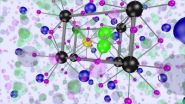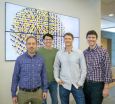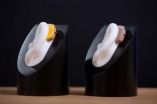(Press-News.org) The term a "brighter future" might be a cliché, but in the case of ultra-small probes for lighting up individual proteins, it is now most appropriate. Researchers at the U.S. Department of Energy (DOE)'s Lawrence Berkeley National Laboratory (Berkeley Lab) have discovered surprising new rules for creating ultra-bright light-emitting crystals that are less than 10 nanometers in diameter. These ultra-tiny but ultra-bright nanoprobes should be a big asset for biological imaging, especially deep-tissue optical imaging of neurons in the brain.
Working at the Molecular Foundry, a DOE national nanoscience center hosted at Berkeley Lab, a multidisciplinary team of researchers led by James Schuck and Bruce Cohen, both with Berkeley Lab's Materials Sciences Division, used advanced single-particle characterization and theoretical modeling to study what are known as "upconverting nanoparticles" or UCNPs. Upconversion is the process by which a molecule absorbs two or more photons at a lower energy and emits them at higher energies. The research team determined that the rules governing the design of UCNP probes for ensembles of molecules do not apply to UCNP probes designed for single-molecules.
"The widely accepted conventional wisdom for designing bright UCNPs has been that you want to use a high concentration of sensitizer ions and a relatively small concentration of emitter ions, since too many emitters will result in self-quenching that leads to lower brightness, says Schuck, who directs the Molecular Foundry's Imaging and Manipulation of Nanostructures Facility. "Our results show that under the higher excitation powers used for imaging single particles, emitter concentrations should be as high as possible without compromising the structure of the nanocrystal, while sensitizer content can potentially be eliminated."
Schuck and Cohen are the corresponding authors of a paper describing this research in Nature Nanotechnology. The paper is titled "Engineering bright sub-10-nm upconverting nanocrystals for single-molecule imaging." Co-authors are Daniel Gargas, Emory Chan, Alexis Ostrowski, Shaul Aloni, Virginia Altoe, Edward Barnard, Babak Sanii, Jeffrey Urban and Delia Milliron.
Proteins are one of the fundamental building blocks of biology. The cells that make up tissues and organs are constructed from assemblies of proteins interacting with other biomolecules, while other proteins control nearly every chemical process inside a cell. Studying the location, assembly, and movement of specific proteins is essential for understanding how cells function and what goes wrong in diseased cells. Scientists often study proteins within cells by labeling them with light-emitting probes, but finding probes that are bright enough for imaging but not so large as to disrupt the protein's function has been a challenge. Fluorescent organic dye molecules and semiconductor quantum dots meet the size requirements but impose other limitations.
"Organic dyes and quantum dots will blink, meaning they randomly turn on and off, which is quite problematic for single-molecule imaging, and will photobleach, turn-off permanently, usually after less than 10 seconds under most imaging conditions," Schuck says.
Five years ago, Cohen and Schuck and their colleagues at the Molecular Foundry synthesized and imaged single UCNPs made from nanocrystals of sodium yttrium fluoride (NaYF4) doped with trace amounts of the lanthanide elements ytterbium, for the sensitizer ions, and erbium, for the emitter ions. These UCNPs were able to upconvert near-infrared photons into green or red visible light, and their photostability makes them potentially ideal luminescent probes for single-molecule imaging.
"Cells don't naturally contain lanthanides, so they don't upconvert light at all, which means we can image without any measurable background," Cohen says. "And we can excite with near-infrared light, which is a lot less damaging to cells than visible or ultraviolet light. These are great properties, but to make our UCNPs more compatible with cellular imaging, we had to develop new synthetic methods to make them smaller."
However, when Foundry scientists shrunk UCNP size, following the conventional design rules, they found that loss of brightness became a major issue. UCNPs smaller than 10 nanometers were no longer bright enough for single molecule imaging. This prompted the new study, which showed that factors known to increase brightness in bulk experiments lose importance at higher excitation powers and that, paradoxically, the brightest probes under single-molecule excitation are barely luminescent at the ensemble level.
"This discovery came about really as a consequence of the multidisciplinary collaborative environment at the Molecular Foundry," says Daniel Gargas, co-lead author of the Nature Nanotechnology paper. "By utilizing our daily contact and friendships with scientists throughout the Foundry, we were able to perform highly advanced research on nanoscale materials that included the study of single-molecule photophysics, the ability to synthesize ultra-small upconverting nanocrystals of almost any composition, and the advanced modeling/simulation of UCNP optical properties. There aren't many facilities in the world that can match this collaborative atmosphere with such high levels of scientific characterization."
UCNPs make use of sensitizer ions, such as ytterbium, with relatively large photon absorption cross-sections, to absorb incoming light and transfer this absorbed energy to emitter ions, such as erbium, which luminesce. The original lanthanide-doped UCNPs contained 20-percent ytterbium and 2-percent erbium, which were believed to be the optimal concentrations for brightness in both bulk and nanocrystals. However, the new Molecular Foundry study showed that for UCNPs smaller than 10 nanometers, the erbium concentration could be raised to 20-percent and the ytterbium concentration could be reduced to 2-percent, or even eliminated for UCNPs approaching five nanometers.
"People often assume that particles that are the brightest at low powers will also be the brightest at high powers, but we found our ultra-small UCNPs to be a classic tortoise-and-hare example," says Emory Chan, the other co-lead author of the Nature Nanotechnology paper. "UCNPs heavily doped with erbium start slowly out of the gate, being incredibly dim at low powers, but by the time the laser intensity is cranked up to high power, they have passed up the conventionally doped UCNPs that are the high-flyers at low powers."
Chan's computer models predict that the new rules are universal for lanthanide-doped nanocrystal hosts and he is now using the Foundry's WANDA robot (Workstation for Automated Nanomaterial Discovery and Analysis), which he developed along with co-author Delia Milliron, to create and screen for the best UCNP compositions based on different operation/application considerations and criteria.
In the course of discovering the new rules for designing ultra-small UCNPs, the research team also discovered that complex levels of heterogeneity exist within the emission spectra of these UCNPs. This suggests that emissions from the UCNPs may be originating from only a small subset of the total emitters.
"Future studies may determine how to engineer particles consisting of only these super-emitters resulting in even brighter emissions from ultra-small UCNPs," Gargas says.
INFORMATION:
This research was supported by the DOE Office of Science.
Lawrence Berkeley National Laboratory addresses the world's most urgent scientific challenges by advancing sustainable energy, protecting human health, creating new materials, and revealing the origin and fate of the universe. Founded in 1931, Berkeley Lab's scientific expertise has been recognized with 13 Nobel prizes. The University of California manages Berkeley Lab for the U.S. Department of Energy's Office of Science. For more, visit http://www.lbl.gov.
The Molecular Foundry is one of five DOE Nanoscale Science Research Centers (NSRCs), national user facilities for interdisciplinary research at the nanoscale, supported by the DOE Office of Science. Together the NSRCs comprise a suite of complementary facilities that provide researchers with state-of-the-art capabilities to fabricate, process, characterize and model nanoscale materials, and constitute the largest infrastructure investment of the National Nanotechnology Initiative. The NSRCs are located at DOE's Argonne, Brookhaven, Lawrence Berkeley, Oak Ridge and Sandia and Los Alamos National Laboratories. For more information about the DOE NSRCs, please visit http://science.energy.gov.
DOE's Office of Science is the single largest supporter of basic research in the physical sciences in the United States, and is working to address some of the most pressing challenges of our time. For more information, please visit the Office of Science website at science.energy.gov/.
Bright future for protein nanoprobes
Berkeley Lab researchers discover new rules for single-particle imaging with light-emitting nanocrystals
2014-03-18
ELSE PRESS RELEASES FROM THIS DATE:
First guidelines for patients with pulmonary hypertension in sickle cell disease
2014-03-18
(Boston) –Boston Medical Center (BMC) and Boston University School of Medicine (BUSM) physicians have helped create the first set of clinical guidelines for treating patients with pulmonary hypertension in sickle cell disease. Elizabeth Klings, MD, director of the pulmonary hypertension inpatient and education program at BMC and associate professor of medicine at BUSM, spearheaded the development of these guidelines, which are published in the American Journal of Respiratory and Critical Care Medicine.
Several studies conducted in the past decade have demonstrated that ...
Moffitt researchers discover new mechanism allowing tumor cells to escape immune surve
2014-03-18
The immune system plays a pivotal role in targeting cancer cells for destruction. However, tumor cells are smart and have developed ways to avoid immune detection. A collaborative team of researchers at Moffitt Cancer Center recently discovered a novel mechanism that lung cancer cells use to block detection by a type of immune cell called a natural killer cell (NK cell).
NK cells find and destroy virally infected cells and also play an important role in detecting and killing tumor cells. However, tumors produce high amounts of a protein called Transforming Growth ...
Reducing anxiety with a smartphone app
2014-03-18
Playing a science-based mobile gaming app for 25 minutes can reduce anxiety in stressed individuals, according to research published in Clinical Psychological Science, a journal of the Association for Psychological Science.
The study suggests that "gamifying" a scientifically-supported intervention could offer measurable mental health and behavioral benefits for people with relatively high levels of anxiety.
"Millions of people suffering from psychological distress fail to seek or receive mental health services. A key factor here is that many evidence-based treatments ...
Only 1 fifth of people with hearing problems wear a hearing aid
2014-03-18
Just a fifth of people with hearing problems wear a hearing aid, a study by The University of Manchester has found.
The study, published in the journal Ear and Hearing, looked at the habits of 160,000 people in the UK aged 40 to 69 years. It found 10.7 per cent of adults had significant hearing problems when listening to speech in the presence of background noise - but only 2.1 per cent used a hearing aid.
One in 10 middle aged adults had substantial hearing problems and were more likely to be from a working class or ethnic minority background.
Dr Piers Dawes, from ...
Scent of the familiar: You may linger like perfume in your dog's brain
2014-03-18
An area of the canine brain associated with reward responds more strongly to the scents of familiar humans than it does to the scents of other humans, or even to those of familiar dogs.
The journal Behavioural Processes published the results of the first brain-imaging study of dogs responding to biological odors. The research was led by Gregory Berns, director of the Center for Neuropolicy at Emory University.
"It's one thing when you come home and your dog sees you and jumps on you and licks you and knows that good things are about to happen," Berns says. "In our experiment, ...
Analysis of 50 years of hit songs yields tips for advertisers
2014-03-18
Researchers from North Carolina State University have analyzed 50 years' worth of hit songs to identify key themes that marketing professionals can use to craft advertisements that will resonate with audiences.
"People are exposed to a barrage of advertisements and they often respond by tuning out those advertisements. We wanted to see what we could learn from hit songs to help advertisers break through all that clutter," says Dr. David Henard, a professor of marketing at NC State and lead author of a paper describing the research. "We also wanted to see if there were ...
Rats' brains may 'remember' odor experienced while under general anesthesia
2014-03-18
Rats' brains may remember odors they were exposed to while deeply anesthetized, suggests research in rats published in the April issue of Anesthesiology.
Previous research has led to the belief that sensory information is received by the brain under general anesthesia but not perceived by it. These new findings suggest the brain not only receives sensory information, but also registers the information at the cellular level while anesthetized without behavioral reporting of the same information after recovering from anesthesia.
In the study, rats were exposed to a ...
NSF-funded researchers say Antarctic telescope may have provided the first direct evidence of cosmic
2014-03-18
Researchers with the National Science Foundation-funded BICEP2 Collaboration today announced that their telescope in Antarctica has allowed them to collect what they believe is the first direct evidence for cosmic inflation.
Inflation is the cataclysmic event in which, in a fleeting fraction of a second following the Big Bang, the infant universe expanded exponentially, stretching far beyond the view of the best telescopes.
Modern astronomy is built around the theory that almost 14 billion years ago, the universe burst into existence in an extraordinary event that ...
A novel mechanism for fast regulation of gene expression
2014-03-18
VIDEO:
Ben-Shahar describes research with fruit flies that shows messenger RNA plays an active as well as a passive role in the cell. In addition to encoding for a protein, it...
Click here for more information.
Our genome, we are taught, operates by sending instructions for the manufacture of proteins from DNA in the nucleus of the cell to the protein-synthesizing machinery in the cytoplasm. These instructions are conveyed by a type of molecule called messenger RNA (mRNA).
Francis ...
New lens design drastically improves kidney stone treatment
2014-03-18
DURHAM, N.C. -- Duke engineers have devised a way to improve the efficiency of lithotripsy -- the demolition of kidney stones using focused shock waves. After decades of research, all it took was cutting a groove near the perimeter of the shock wave-focusing lens and changing its curvature.
"I've spent more than 20 years investigating the physics and engineering aspects of shock wave lithotripsy," said Pei Zhong, the Anderson-Rupp Professor of Mechanical Engineering and Materials Science at Duke University. "And now, thanks to the willingness of Siemens (a leading lithotripter ...
LAST 30 PRESS RELEASES:
Making lighter work of calculating fluid and heat flow
Normalizing blood sugar can halve heart attack risk
Lowering blood sugar cuts heart attack risk in people with prediabetes
Study links genetic variants to risk of blinding eye disease in premature infants
Non-opioid ‘pain sponge’ therapy halts cartilage degeneration and relieves chronic pain
AI can pick up cultural values by mimicking how kids learn
China’s ecological redlines offer fast track to 30 x 30 global conservation goal
Invisible indoor threats: emerging household contaminants and their growing risks to human health
Adding antibody treatment to chemo boosts outcomes for children with rare cancer
Germline pathogenic variants among women without a history of breast cancer
Tanning beds triple melanoma risk, potentially causing broad DNA damage
Unique bond identified as key to viral infection speed
Indoor tanning makes youthful skin much older on a genetic level
Mouse model sheds new light on the causes and potential solutions to human GI problems linked to muscular dystrophy
The Journal of Nuclear Medicine ahead-of-print tip sheet: December 12, 2025
Smarter tools for peering into the microscopic world
Applications open for funding to conduct research in the Kinsey Institute archives
Global measure underestimates the severity of food insecurity
Child survivors of critical illness are missing out on timely follow up care
Risk-based vs annual breast cancer screening / the WISDOM randomized clinical trial
University of Toronto launches Electric Vehicle Innovation Ontario to accelerate advanced EV technologies and build Canada’s innovation advantage
Early relapse predicts poor outcomes in aggressive blood cancer
American College of Lifestyle Medicine applauds two CMS models aligned with lifestyle medicine practice and reimbursement
Clinical trial finds cannabis use not a barrier to quitting nicotine vaping
Supplemental nutrition assistance program policies and food insecurity
Switching immune cells to “night mode” could limit damage after a heart attack, study suggests
URI-based Global RIghts Project report spotlights continued troubling trends in worldwide inhumane treatment
Neutrophils are less aggressive at night, explaining why nighttime heart attacks cause less damage than daytime events
Menopausal hormone therapy may not pose breast cancer risk for women with BRCA mutations
Mobile health tool may improve quality of life for adolescent and young adult breast cancer survivors
[Press-News.org] Bright future for protein nanoprobesBerkeley Lab researchers discover new rules for single-particle imaging with light-emitting nanocrystals







